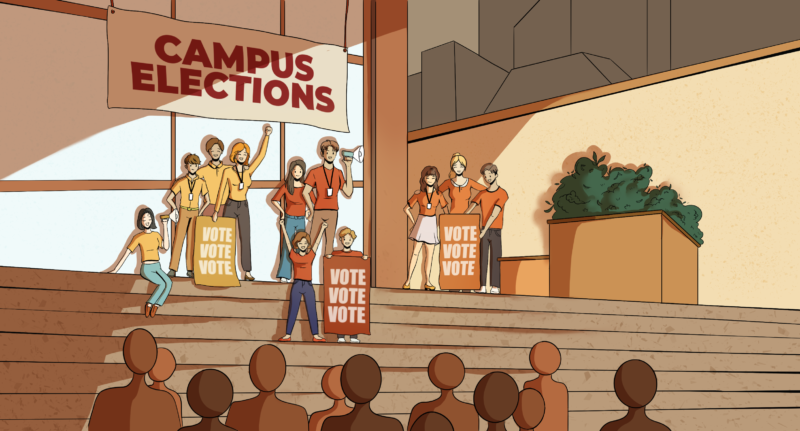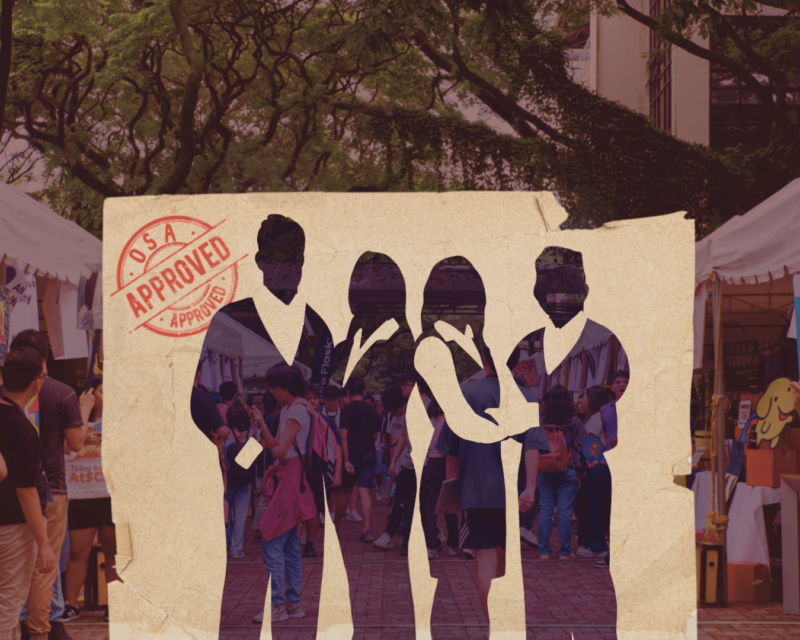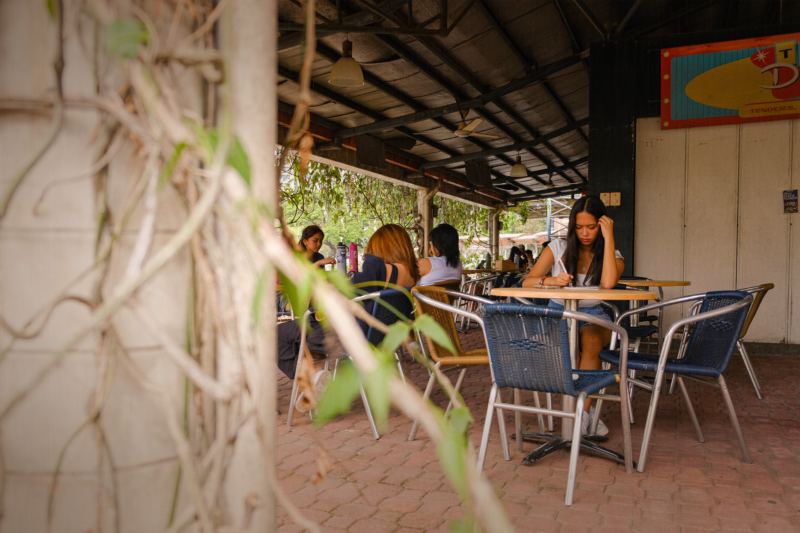Illustration by Jan-Daniel S. Belmonte, Chelli V. Reyes and Charisse B. Tacang
Plastered all over campus are posters telling students not to pet or feed the cats. The poster campaign, set up by the office of the Associate Dean for Student Affairs (ADSA), the Loyola Schools Office of Health Services and the Office of Administrative Services (OAS), aims to curb the rising number of injuries caused by cat bites and scratches.
There are over 36 identified cats living on campus, says the OAS. ADSA reports a total of eight cases of animal-related injuries from last school year; most of them cat bites and scratches. The OAS also receives complaints about sanitation, as these cats are known to frequent the school’s cafeterias.
The poster campaign is the school’s most visible way of showing support for animal rights, and sadly it seems to be the only way. Despite being just a kilometer or two away from the Philippine Animal Welfare Society’s (PAWS) rehabilitation center, the Ateneo still has no prominent animal rights group.
Humane solution
“Cats have been around [campus] since I was in college,” says Cholo Mallilin, assistant to the ADSA for student services. “But when I entered back in 2009, I noticed that there were more cases of students being scratched or bitten.”
He recalls a case from 2010 when a cat scratched a foreign exchange student. “He had a hard time getting treatment,” explains Mallilin. “When he found out that the rabies shot would cost him around P7,000 [from the school infirmary], we referred him to a government hospital. He got treatment but it still cost him a lot.”
“Medical reimbursements from animal bites and scratches have even surpassed [reimbursements from] sports injuries,” says Mallilin. ADSA reimbursed a total of P151,433.83 in student insurance claims last school year for animal-related injuries.
To counter the rising number of cat-related injuries, the university’s current policy is to provide a humane way to remove them from campus, says Mallilin. The OAS has contracted a professional and authorized animal handler to bring these cats to animal welfare shelters. The whole process is in accordance with the Animal Welfare Act of 1998 (Republic Act No. 8485), which aims to promote and protect the welfare of animals by supervising and regulating establishments that use animals for either trade or pets.
However, this process is currently on hold, says Malilin. He says that, for now, the best way that ADSA can raise awareness is through the poster campaign. “A lot of students treat these cats like they’re tame but they’re not. What we want is for them to be treated like pests,” he adds.
The school also recently got in trouble with animal rights groups. PAWS Administrative Officer Charlene Laxamana says, “We filed a case against one of the [staff in Ateneo] in one of your cafeterias for sacking cats, with the purpose of getting rid of them.”
She adds that that is one of the reasons why the Trap-Neuter-Release (TNR) program is one of PAWS’ biggest projects. TNR is a long-term sustainable solution. “Realistically speaking, even if we call the city pound to get rid of the stray cats every week, you will never ever get rid of a cat population. No matter how clean, no matter how exclusive the place is,” says Laxamana.
Animal advocates
While the Ateneo does not have a clear stand on animal welfare, schools like the University of the Philippines (UP), University of Santo Thomas (UST), and De La Salle University (DLSU) have pledged their support.
UP’s Diliman and Los Baños campuses both have their own animal welfare groups. Claws UP, an organization founded by UP Diliman students, is tied up with several animal welfare groups such as the Earth Island Institute and the Animal Kingdom Foundation. Their Facebook page is described as “an online portal wherein netizens can report or post animal cruelty within campus boundaries and at the same time be informed about animal rights and welfare.”
On their end, DLSU’s University Student Government has written up a manifesto pushing for improved animal welfare laws in the Philippines. Even regular DLSU students have shown their support for animal welfare. Former Green Tanker Hanna Sanchez, for instance, participated in a charity swim that aimed to raise funds for several animal welfare organizations.
UST’s official student publication, The Varsitarian, has published pieces calling for the stronger implementation of animal welfare laws. Moreover, the school’s animal laboratory prescribes to standards set in the Animal Welfare Act of 1998.
The Ateneo Biological Organization (BOx) has called itself the “premier advocate of animal welfare” of the school on their website, despite not having any prominent projects with regards to animal rights.
BOx President Antoni Martija says that the organization’s vision has shifted from its animal welfare advocacy to biodiversity as a whole. Animal welfare was “too narrow a vision” for BOx, “because they also wanted to shed light on environmental issues.”
Domestic action
Without any sole organization to champion the cause, animal welfare is often overlooked in the Ateneo.
According to Laxamana, BOx came to PAWS in 2011,“wanting to work with” them, as far as “information dissemination is concerned.” Martija says that PAWS gives talks about responsible pet ownership every January during BOx week. “BOx week talks are open to everyone, but hardly anyone appears,” adds BOx Vice President Cherise Llaneta.
“We also have an animal house in the Ateneo,” mentions Martija. According to Dr. Janice Ragaza, assistant professor at Biology Department, the Biological Research House is a small shed that houses live animals used for observation and experimentation by students for class projects. She emphasizes, “Everything is all very humane.” Moreover, the satellite laboratory has begun institutionalizing protocols on animal ethics that the university will be adopting in the future.
Martija says that for students to be able to acquire access to the research house, they must have several permits signed by certain authorities at the Biology Department. The Biological Research House is located at the end of the bridge found beside the Gonzaga tricycle shed.
With regard to animal experimentation during class, Llaneta recalls, “the dead cats we experimented on were provided by UST, already containing the correct chemicals, and for only P200 each.”
Laxamana says that Ateneans have dropped by PAWS, specifically asking for permission to observe and non-invasively experiment on their animals. “PAWS is not the right agency to approach for that,” says Laxamana. Instead, she refers students to the Philippine Association for Laboratory Animal Science for experimentation queries.
“We do not support nor encourage animal experimentation. We take care of animals who have been victims of cruelty and neglect, the last thing they need is to be study subjects,” explains Laxamana.
The ongoing fight
Without cats on campus, vermin would thrive. Without a regular food source, these cats are dependent on the kindness of students and staff. During typhoons, cats seek shelter where they can. When cats die from natural causes or are run over, utility men bury them.
PAWS highly encourages student bodies to pursue animal welfare. “It’s a matter of taking just one step forward that would help the animals that you love,” says Laxamana. “A lot of animals need our help, and there’s just not one group that can do everything.”
According to Laxamana, “Most universities are now open to including animal welfare in their curriculum.” Schools like the British International School of Manila have “incorporated animal welfare” into their community service programs. “We’re trying to get the entire school system injected with animal welfare,” says Laxamana.
Claws UP President Vino Lucero says implementing animal welfare policies in a school is “basically a struggle.” Lucero explains that the UP administration must already be having a hard time “observing animal welfare while maximizing the resources for members of the academe.” Lucero says that they’re planning to build a cat shelter in the Diliman campus, while UP continues to practice their TNR program on their 300 resident cats.
“Keep feral cats feral,” says Laxamana. It’s the best students can do, without any cat management program in place.
Updated on October 9, 2014 at 12:35 PM.







